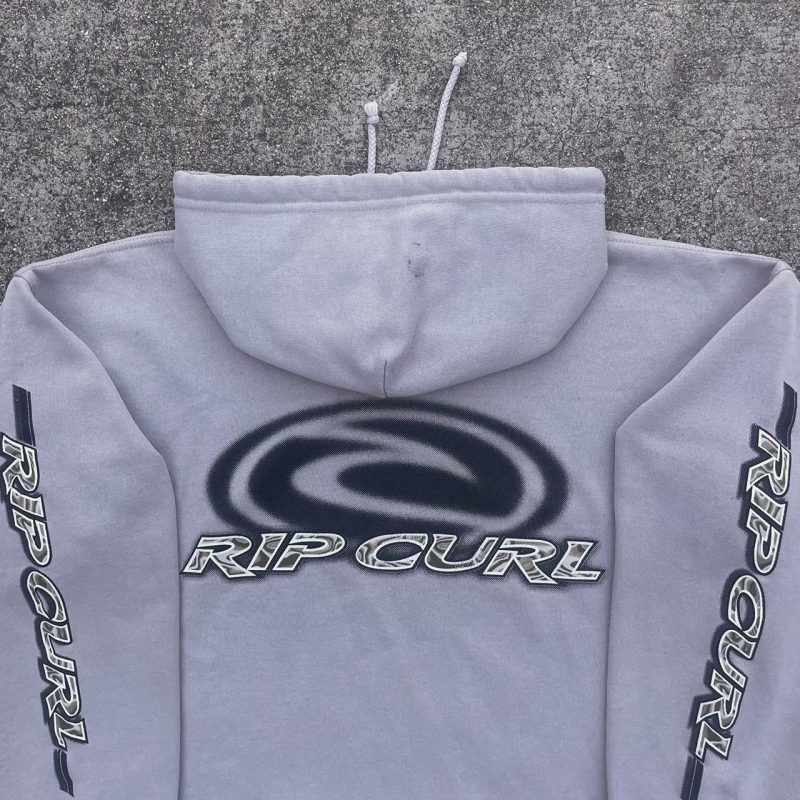
Why is Vintage Surfwear so Expensive?
Surf’s up. Skate’s down.
As we predicted last year surfwear is having its moment—again. But this time, it’s not just about mall nostalgia or moodboard-core y2k. Collectors are looking past the Hollister revival and diving in deeper. The latest tees on the rise are the true shortboard-revolution era stuff, the brands that defined surf counterculture in the ‘70s and ‘80s. Vintage collectors have caught up to the aesthetic, and the market is responding. Here are some brands to look out for and why we think they’re a good buy right now.
Take Lightning Bolt, founded in 1971 on Oahu, and rumored to be named after a particularly potent local strain of weed. The surfboard brand’s clean bolt logo, stripped down, iconic, unmistakably cool, has quietly found collector status.. Polos and tees from the 70s and 80s are now commanding prices north of $150, with rarer variants fetching even more. That same year, Town & Country Surf opened its doors, staking out a small surf shop on Kamehameha Highway and a reputation for their boards. The now-iconic yin-yang logo, originally suggested by a local T-shirt artist, was great design and symbolic of the balance between Oahu’s cultural poles. Today, T&C tees from the 70s and 80s regularly top $500, and demand is climbing.

The same applies to Gotcha, founded as a boardshort brand in the late 70s and peaking in the neon-drenched surf boom of the ‘80s. With aggressive slogans like “If you don’t surf or skate don’t start,” Gotcha separated the world into posers and surfers. Their early gear had real edge: punk graphics, acid colors, and quality cut & sew silhouettes. But by the late 90s mass adoption and overproduction diluted the brand’s edge, and it lost its subcultural identity. Now, with nostalgia peaking and following a Brain Dead collaboration, certain Gotcha tees are approaching $200+, especially the bold graphic stuff.
Maui & Sons started as a cookie company in Malibu—but by 1980, they’d pivoted to boardshorts, and their psychedelic graphics (and cookie logo) helped define a generation of Californian surfwear. Their ad campaigns rarely focused on the clothes. Instead, you got mutant fish, shark men, and neon dreamscapes. Tees featuring the Sharkman mascot are hitting $100 or more, and their original posters have become collectibles in their own right.
And then there’s Stussy. Started by board shaper Shawn Stussy in the early 80s, it was a board brand first. But by the mid-80s, the clothes had eclipsed the boards entirely. Stussy has done what few surf brands have managed: evolve. They moved with the times, into skate, then into streetwear, then hip-hop, then fashion without ever losing their cool. Vintage Stussy from the 80s and 90s are hotter than ever, with tees going for upwards of $1,000. Perhaps the most salient indicator for the brand is that Travis Scott wears vintage Stussy, love him or hate him any vintage Scott wears turns to gold.
Across the board, surf graphics feel like a breath of fresh air: bright, tropical, ironic, chaotic. In many ways the surfwear look is the antithesis of the faded-black-tee-Opium look but still just as punk at its core. In a vintage space increasingly clogged with earth-toned workwear and endless Carhartt jackets, this stuff pops. It plays nice with Y2K-sleaze but it’s got deeper roots and broader legs. It’s closer to the roots of early 70s climbing wear than to Hollister. It’s punk-adjacent but not nihilistic. It’s rare, under-referenced, and brimming with potential.
Compare that to skatewear, where demand has cooled off drastically. Shorty’s, Hook-Ups, World Industries, and Zero tees that once sold in minutes for prices in the hundreds are sitting. Even early Supreme–arguably the crown jewel of the skate/streetwear crossover–is more of a streetwear story than a pure skate one now. The problem isn’t the brand history and mythology. It’s the oversaturation and overrepetition. Between reissues, bootlegs, tribute lines, and TikTok trends, the juice has been fully squeezed. Everyone already thrifted this stuff. It’s not rare, and it’s not exciting. The graphic language of 90s skatewear; flames, skeletons, devils, boobs; is wearing thin. Skatewear isn’t dead but it’s certainly not on the come up.
Surfwear, on the other hand, is getting ready for its next big wave. It hasn’t been reissued to death. It hasn’t been commodified by every fast fashion brand on the planet–recently. It’s got stories, history, and graphics that feel genuinely new again.


Discussion
Be the first to leave a comment